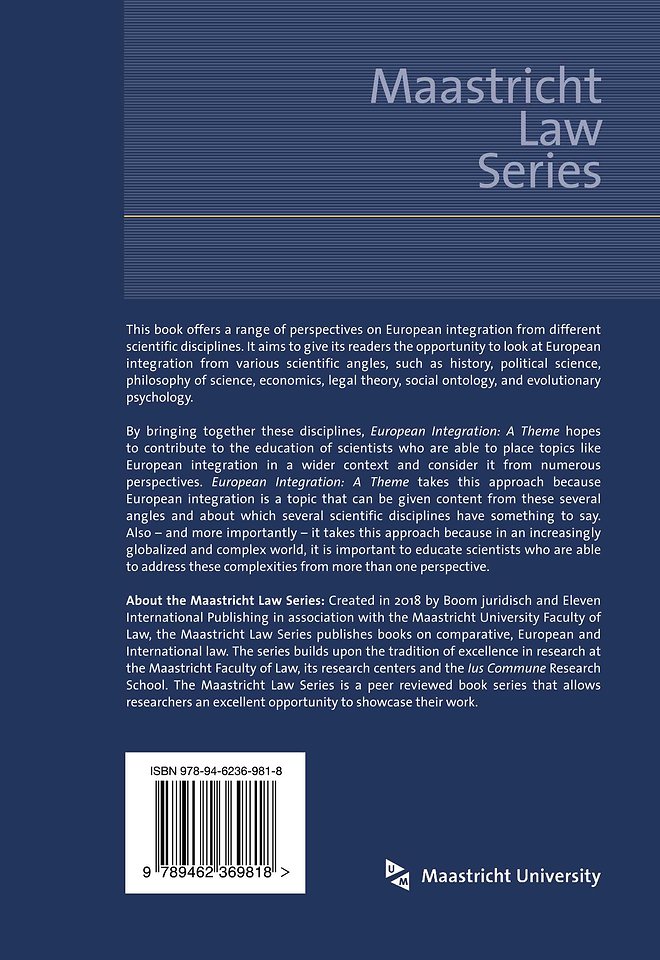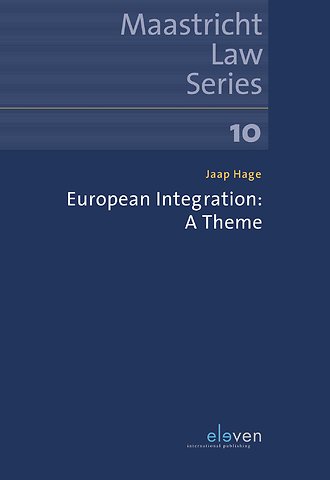



Jaap Hage is Professor of Jurisprudence at Maastricht University and Fellow of the Maastricht European Private Law Institute (M-EPLI), Maastricht University.
Meer over Jaap HageEuropean Integration: A Theme
Samenvatting
This book offers a range of perspectives on European integration from different scientific disciplines. It aims to give its readers the opportunity to look at European integration from various scientific angles, such as history, political science, philosophy of science, economics, legal theory, social ontology, and evolutionary psychology.
By bringing together these disciplines, European Integration: A Theme hopes to contribute to the education of scientists who are able to place topics like European integration in a wider context and consider it from numerous perspectives. European Integration: A Theme takes this approach because European integration is a topic that can be given content from these several angles and about which several scientific disciplines have something to say. Also – and more importantly – it takes this approach because in an increasingly globalized and complex world, it is important to educate scientists who are able to address these complexities from more than one perspective.
Trefwoorden
Specificaties
Inhoudsopgave
1 Pre-History 1
1.1 The Western Roman Empire 1
1.2 The Byzantine Empire 3
1.3 The Franks 4
1.4 Religion Matters 6
1.5 Liberalism 8
1.5.1 Four Factors that Caused the Rise of Liberalism 9
1.5.2 Thomas Hobbes and the Pursuit of Self-Interest 11
1.5.3 Characteristics of Liberalism 12
1.5.4 John Locke and the Preservation of Natural Rights 13
1.5.5 Cosmopolitism 15
1.5.6 Free Trade 16
1.6 The French Revolution and Its Aftermath 16
1.6.1 Conservatism 17
1.6.2 Napoleon Bonaparte 18
1.7 The Rise of Socialism 19
1.8 The 20th Century 22
2 The History of the European Union, in Four Phases 23
2.1 Introduction 23
2.2 The Treaties 23
2.3 The Communities and Their Organs 25
2.4 Economic Integration 27
2.5 Enlargement 29
2.6 The European Coal and Steel Community 31
2.6.1 Cold War 32
2.6.2 Relations between France and Germany 33
2.6.3 The Schuman Declaration 34
2.6.4 The European Coal and Steel Community 34
2.6.5 Technocracy and National Interests 35
2.6.6 Conclusion on the ECSC 37
2.7 The Empty Chair Crisis 38
2.8 Towards the European Union 40
2.9 The EU in Crisis 43
2.10 From Spillover to Spillback 46
3 Theories of European Integration 47
3.1 Federalism 47
3.1.1 The Ventotene Manifesto 47
3.1.2 The Legal Perspective 49
3.1.3 The Political Science Perspective: Federal Unions 50
3.2 Functionalism 51
3.3 Neo-functionalism 53
3.4 Intergovernmentalism 57
3.5 Some Defining Distinctions 58
3.6 Evaluation 59
3.6.1 Functionalism and Legal Federalism 59
3.6.2 Sociological Federalism 60
3.6.3 Neo-functionalism and Intergovernmentalism 61
4 Explanation and Understanding 63
4.1 The Relationship between Explanation and Understanding 63
4.2 The Nomological-Deductive Model of Explanation 66
4.2.1 Explanation as Logical Derivation 66
4.2.2 What is a Law? 67
4.2.3 Legal Explanation 68
4.3 The Scientific (Empirical) Cycle 70
4.3.1 A Priori and Empirical 71
4.3.2 Steps in the Empirical Cycle 71
4.3.3 Observation 73
4.3.4 Law Formulation and Induction 74
4.3.5 Deduction and Prediction 74
4.3.6 Observation and Testing 75
4.3.7 Evaluation 75
4.3.8 Non-empirical Science 77
4.3.9 Application to Integration Theories 78
4.4 What Makes a Theory ‘Scientific’? 81
4.5 Teleological Explanation 84
4.5.1 Limitations of the ND Model in Connection with Human Behaviour 84
4.5.2 Goal-Based Explanation 86
4.6 Application to the Integration Theories 89
4.7 Conclusion 90
5 The Economics of Trade: Basic Concepts 91
5.1 The Economic Style of Thinking 91
5.2 Some Concepts 93
5.3 Transaction Costs 97
5.3.1 Internal Costs and Benefits 97
5.3.2 Definition of Transaction Costs 97
5.3.3 Taxation 98
5.3.4 Summary on Transaction Costs 100
5.4 Externalities 101
5.4.1 Introduction 101
5.4.2 Costs, Benefits and Decisions 102
5.5 Social Dilemmas 103
5.5.1 Definition 103
5.5.2 Internalizing Externalities 105
5.5.3 Externalities and Free Trade 106
6 The Economics of International Trade 109
6.1 Mercantilism and Free Trade 109
6.1.1 Mercantilist Policies 109
6.1.2 Is there a Fixed Amount of Wealth? 111
6.2 Absolute and Comparative Advantages 112
6.2.1 Absolute Advantage 112
6.2.2 Comparative Advantage 113
6.2.3 Conclusion on Absolute and Relative Advantages 115
6.3 The (Dis)Advantages of Free International Trade 116
6.3.1 Consumer and Producer Surplus 116
6.3.2 Allowing Free International Trade in a Small Country 119
6.3.3 Allowing Free International Trade in a Big Country 122
6.3.4 Tariffs 123
6.4 Conclusion 124
7 Money 127
7.1 What Is Money? 127
7.1.1 Coincidence of Wants 127
7.1.2 Overview 128
7.1.3 The Functions of Money 128
7.1.4 The Forms of Money 130
7.2 The Creation of Money 130
7.2.1 Money Creation by Banks 131
7.2.2 The Role of the Central Bank 132
7.3 The Value of Money 134
7.3.1 Inflation 134
7.3.2 Deflation 135
7.3.3 Interest Rates 135
7.3.4 Exchange Rates 136
7.4 Indirect Taxation 137
7.4.1 Inflation Tax 137
7.4.2 Interest Tax 138
7.4.3 Exchange Rates 138
7.5 Trade Equilibria 139
7.6 The Impossible Trinity 140
7.6.1 If There Were No Full Capital Mobility 141
7.6.2 Exchange Rates, Interest Levels and the Free Flow of Capital 143
7.6.3 Why the Trinity Is Impossible 143
7.7 Conclusion 144
8 Monetary Integration 147
8.1 Attempts at Fixed Exchange Rates 147
8.2 The Road towards the European Monetary Union 148
8.2.1 Drawbacks of Flexible Exchange Rates 148
8.2.2 The Snake in the Tunnel and Other Failed Attempts 149
8.2.3 The Euro 150
8.2.4 The Stability and Growth Pact 151
8.3 Exchange Rates and Asymmetric Shocks 153
8.4 Optimum Currency Areas 156
8.5 Conclusion 158
9 Sovereignty 159
9.1 Introduction 159
9.2 Two Crises 160
9.2.1 The Migration Crisis 160
9.2.2 The Financial Crises 163
9.3 Introducing Sovereignty 166
9.4 Social Reality: Basics 168
9.4.1 Three Kinds of Facts 168
9.4.2 The Existence of Social Facts 169
9.5 Social Reality: Rules and Rule-Based Facts 171
9.5.1 The Main Function of Rules 171
9.5.2 How Rules Exist 172
9.5.3 Rule-Based Facts and Rules 174
9.5.4 Popular Sovereignty 175
9.6 Legal Consequences 177
9.7 Legal Status 179
9.8 External Sovereignty as Legal Status 181
9.9 Internal Sovereignty Is No Legal Status 184
9.10 Conclusion 186
10 Euroscepticism 187
10.1 Introduction 187
10.2 Anywheres and Somewheres 190
10.3 Reason and Passion 191
10.4 The Genetic Basis of Altruism 192
10.5 Dual System Decision-Making 195
10.6 Nature and Nurture in Morality 197
10.7 People Hate to Reconsider 198
10.8 Conclusion 199
Postscript 201
References 203
Anderen die dit e-book kochten, kochten ook
Rubrieken
- cadeauboeken
- computer en informatica
- economie
- filosofie
- flora en fauna
- geneeskunde
- geschiedenis
- gezondheid
- jeugd
- juridisch
- koken en eten
- kunst en cultuur
- literatuur en romans
- mens en maatschappij
- naslagwerken
- non-fictie informatief/professioneel
- paramedisch
- psychologie
- reizen
- religie
- schoolboeken
- spiritualiteit
- sport, hobby, lifestyle
- thrillers en spanning
- wetenschap en techniek
- woordenboeken en taal





